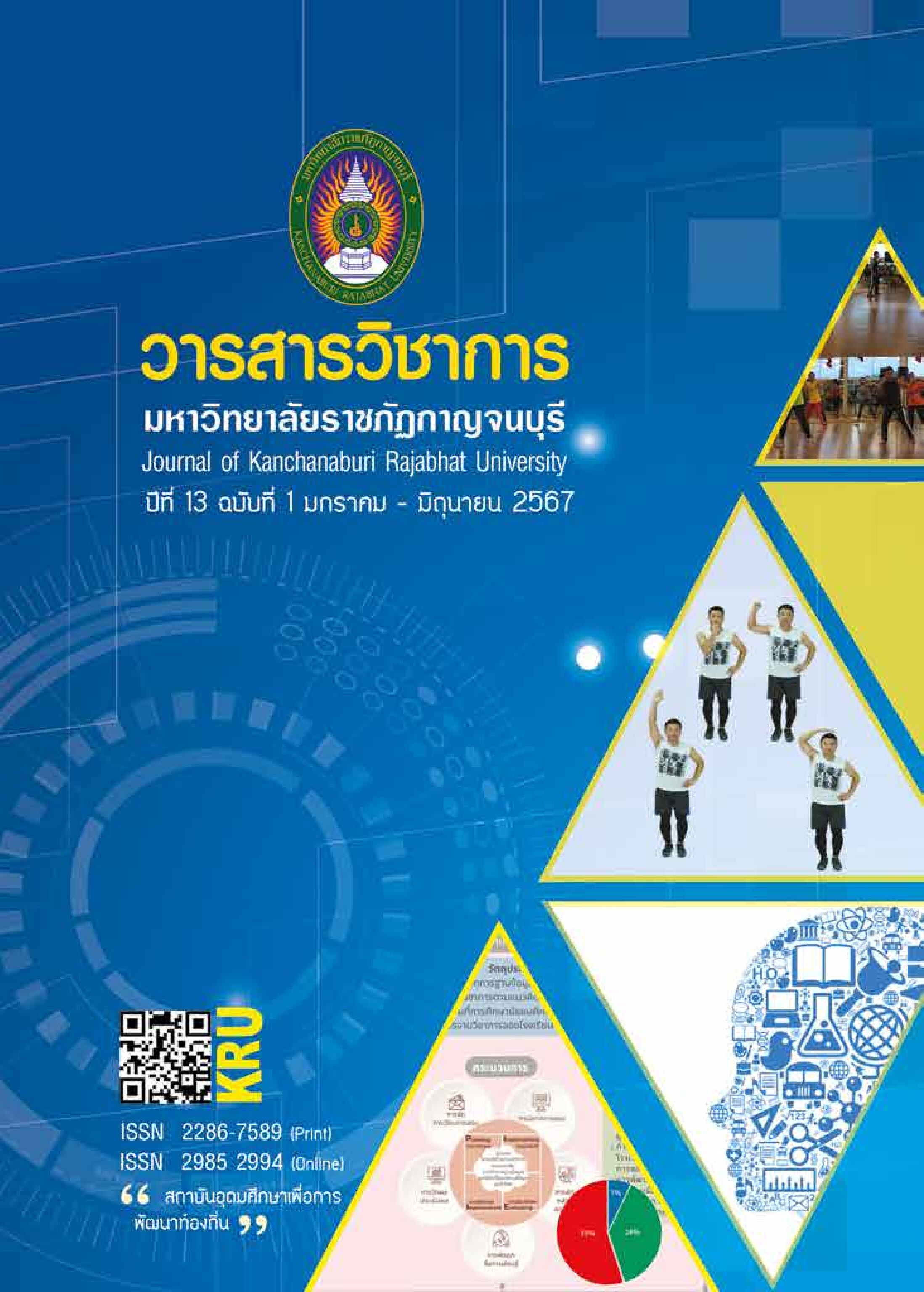แบบจำลองความสัมพันธ์เชิงสาเหตุของปัจจัยที่มีอิทธิพลต่อผลการดำเนินงานของผู้ผลิตชิ้นส่วนยานยนต์ในประเทศไทย
Main Article Content
Abstract
Thailand’s main income comes from exports, especially from the automotive industry which is globally recognized for the quality production base. This research investigates the multifaceted factors influencing the performance of automotive parts manufacturers in Thailand. Through a combined approach of quantitative research, we explore the direct, indirect, and aggregate effects of these factors. Our study involves 380 participants, selected via purposive sampling from the population of 1,797. Using a structural equation model analysis, we establish a causal relationship model that sheds light on the interplay of these factors.
Our findings highlight the significant direct impact of supply chain management on performance, paving the way for enhanced insights into optimizing automotive parts manufacturing in Thailand. The model's consistency is underscored by robust statistical indicators, with a Chi-square (χ2) =160.089, df = 88, CMIN/DF (χ2/df = 1.819, p = .052, GFI = 949, CFI = 984, AGFI=921, NFI = .966, RMR =.035, RMSEA = .046, PCLOSEF= .681 at 0.05 significant level.
Article Details

This work is licensed under a Creative Commons Attribution-NonCommercial-NoDerivatives 4.0 International License.
References
กัลยา วานิชย์บัญชา. (2556). การวิเคราะห์สมการโครงสร้าง SEM ด้วย AMOS. กรุงเทพฯ: สามลดา.
กรมพัฒนาธุรกิจการค้า กระทรวงพาณิชย์. (2665). สถิติการจดทะเบียนนิติบุคคลคงอยู่ในประเทศไทย. ค้นเมื่อ พฤษภาคม 25, 2565,
จาก http://datawarehouse.dbd.go.th/dbw/menu/est/1.html.
กระทรวงพาณิชย์. (2564). สถิติการค้าระหว่างประเทศ. ค้นเมื่อ มกราคม 5, 2564, จาก http://www2.ops3.moc.go.th/
ธนพล ชูยุคสกุล. (2565). ปัจจัยที่ส่งผลต่อการนำธุรกิจอิเล็กทรอนิกส์มาใช้เพื่อการพัฒนาประสิทธิภาพของวิสาหกิจขนาดกลางและขนาดย่อมในเขตพัฒนา
เศรษฐกิจพิเศษกาญจนบุรี. วิทยานิพนธ์หลักสูตรบริหารธุรกิจมหาบัณฑิต สาขาวิชาหลักสูตรบริหารธุรกิจมหาบัณฑิต แผน ก แบบ ก2
ระดับปริญญามหาบัณฑิต บัณฑิตวิทยาลัย มหาวิทยาลัยศิลปากร.
ธานินทร์ ศิลป์จารุ. (2555). การวิจัยและวิเคราะห์ข้อมูลทางสถิติด้วย SPSS และ AMOS. พิมพ์ครั้งที่ 13. กรุงเทพฯ: บิสซิเนสอาร์แอนด์ดี.
วสุธิดา นักเกษม, ธีระวัฒน จันทึก และ พิทักษ ศิริวงศ. (2566). ความสัมพันธ์เชิงสาเหตุของปัจจัยที่ส่งผลต่อการพัฒนากลยุทธ์การขับเคลื่อนผู้สืบทอดตำแหน่ง
ทางธุรกิจในกลุ่มอุตสาหกรรมบริการดิจิทัลของประเทศไทย. วารสารการบริหารนิติบุคคลและนวัตกรรมท้องถิ่น, 9 (4), 244-263.
สำนักงานคณะกรรมการพัฒนาระบบราชการ และสถาบันเพิ่มผลผลิตแห่งชาติ. (2565). คู่มือการ จัดทำแผนการจัดการความรู้. กรุงเทพฯ: สำนักงานคณะกรรมการ
พัฒนาระบบราชการ และสถาบันเพิ่มผลผลิตแห่งชาติ.
สำนักงานคณะกรรมการส่งเสริมการลงทุน. (2564). คู่มือการขอรับการส่งเสริมทุนประจำปี 2564: อุตสาหกรรมยานยนต์. ค้นเมื่อ พฤษภาคม 25, 2565,
จาก http://www.boi.go.th.
สถาบันเพิ่มผลผลิตแห่งชาติ. (2565). เพิ่มประสิทธิภาพลดต้นทุนการผลิตมาตรฐานการผลิตคุณภาพ. ค้นเมื่อ มีนาคม 25, 2565,
จาก https://www.ftpi.or.th/bds.
Bai, C., and Sarkis, J. (2010). Integrating Sustainability into Supplier Selection with Grey System and Rough Set Methodologies.
International Journal of Production Economics, 124 (1), 252-264.
Bai, C. and Sarkis, J. (2010). Green Supplier Development: Analytical Evaluation Using Rough Set Theory. Journal of Cleaner Production,
, 1200-1210. https://doi.org/10.1016/j.jclepro.2010.01.016.
Browne, M. W., and Cudeck, R. (1993). Alternative ways of assessing model fit. In K. A. Bollen and J. S. Long (Eds.), The Testing structural
equation models (pp. 136-162). Newbury Park, CA: Sage.
Fornell, C., and Larcker, D. F. (1981). Structural Equation Models with Unobservable Variables and Measurement Error: Algebra and
Statistics. Journal of Marketing Research, 18, 382-388. http://dx.doi.org/10.2307/3150980.
Green Jr, K. W., Whitten, D., and Inman, R. A. (2008). The Impact of Logistics Performance on Organizational Performance in a Supply
Chain Context. Supply Chain Management: An International Journal, 13 (4), 317-327.
Henseler J, Ringle C.M, and Sinkovics, R.R. (2009). The Use of Partial Least Squares Path Modeling in International Marketing. Advances
in International Marketing, 20, 277–319.
Hair, J., Black, W., Babin, B., Anderson, R., and Tatham, R. (2010). Multivariate data analysis. (7th edition.). New Jersey: Pearson
Educational International, 666-669.
Joreskog, K.G., and Sorbom, D. (1989). LISREL 9.1: LISREL syntax guide. Chicago: Scientific Software International. 2551-2553.
Kaplan, R., and Norton, D. (1992). The balanced scorecard - measures that drive performance. Harvard Business Review, 71-79.
Kim, K. (2014). The impact of ISO 26000 implementation on sustainable supply chain management and competitive advantage. Retrieve
February 23, 2016, Available from: http://search.proquest.com/docview/1566520356/abstract/2E3CDAB462F345F1PQ/1?
accountid=44377.1746-1751.
Kline, R. B. (2015). Principles and practice of Structural Equation Modeling, (4th edition.). New York: Guilford publications, 137-145.
Lin, Hsiu-Fen, and Szu-Mei Lin. (2008). Technovation: the international journal of technological innovation, entrepreneurship and
technology management, 28 (3), 135-145.
Rogers, E.M. (1995). Diffusion of Innovations. 4th Edition, the Free Press, New York.
Schumacker, R. E. and Lomax, R. G., (2010). A beginner’s guide to structural equation modeling. (3rd edition.). New Jersey: Lawrence
Erlbaum Associates, 76.
Singh, J. and Sirdeshmukh, D. (2000). Agency and Trust Mechanisms in Consumer Satisfaction and Loyalty Judgments. Journal of the
Academy of Marketing Science, 28 (22), 150-167.
Sridharan, R. & Simatupang, T. (2005). An Integrative Framework for Supply Chain Collaboration. The International Journal of Logistics
Management, 16 (2), 257-274.
Srimatupang, T. M., and Sridharan, R. (2005). Supply Chain Discontent. Business Process Management Journal, 11 (4), 15-30.
Tsou, Hung-Tai and Hsu, Sheila Hsuan-Yu. (2015). Performance effects of technology–organization–environment openness, service co-
production, and digital-resource readiness: The case of the IT industry," International Journal of Information Management,
Elsevier, 35 (1), 1-14.
Wheaton, B., Muthén, B., Alwin, D. F., & Summers, G. F. (1977). Assessing Reliability and Stability in Panel Models. Sociological
Methodology, 8, 84–136. https://doi.org/10.2307/270754.
Chanvarasuth. P. Wiriyasermkul and N. Boobjing, V. (2010). A Meiosis Genetic Algorithm, 7th International Conference
on Information Technology: New Generations, Las Vegas, NV, USA, 2010, 285-289, doi: 10.1109/ITNG.2010.152.
Zhu, Q., and Geng, Y. (2001). Integrating environmental issues into supplier selection and management. Greener Management
International, 35 (35), 27-40.


